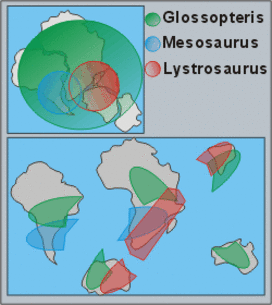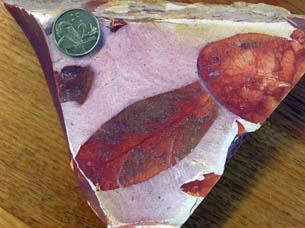Fauna and Flora
Distribution of Glossopteris, Mesosaurus and Lystrosaurus on Gondwana
Image Credit: Griem (2007)
Glossopteris, Australia. Museum of university of Western Australia, Perth
Image Credit: D. Mertmann (2007)
Another line of evidence invoked by Du Toit, Wegener and others to support the existence of supercontinents (Laurasia and Gondwana) in the past involves the distribution of fossils. For instance, it was pointed out that late Paleozoic-middle Mesozoic deposits on the continents of Gondwana preserved similar fossils, such as the extinct seed-fern Glossopteris and the mammal-like reptile Lystrosaurus. Other examples include Cynognathus and the freshwater reptile Mesosaurus. Fossil mesosaurs occur only in South African and South American freshwater deposits. Because it is unlikely that the mesosaurs could have traversed thousands of kilometers of saline open ocean, their geographic distribution confirms other evidence that the continents of the Southern Hemisphere formerly had been joined together. In addition, the basins in which these Mesosaurs occur, the Paraná basin of South America and the Karoo basin of southern Africa, also possess similar stratigraphy and tectonic subsidence histories, again advocating a previous geographic continuity (www.geocities.com/earthhistory/plate.htm).
There is a large number of additional paleontologic evidence and research findings which support the existence of Gondwana as a past supercontinent. In the section "Special Topics", you will find a section "Why marsupials are found".

